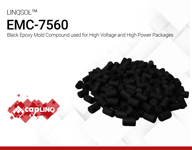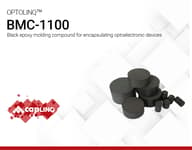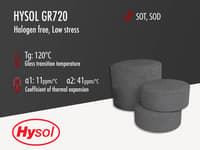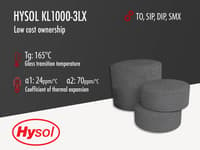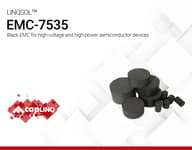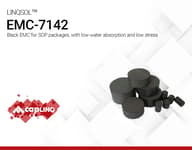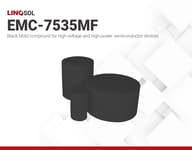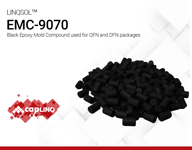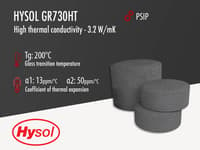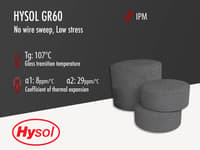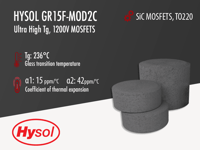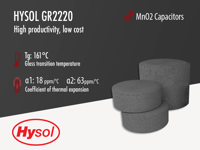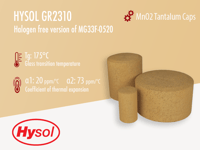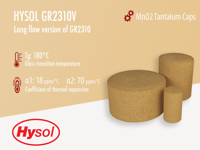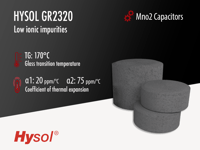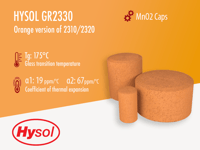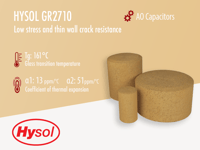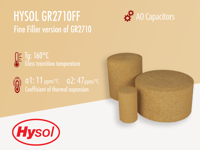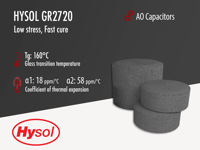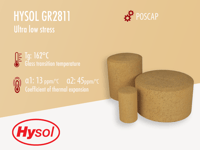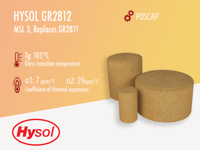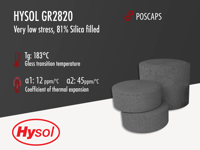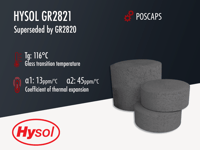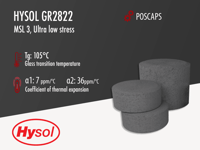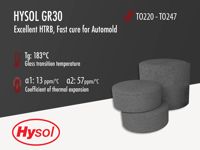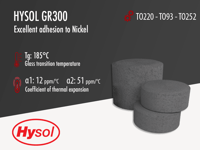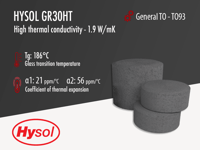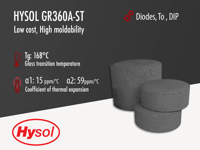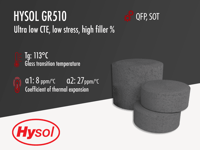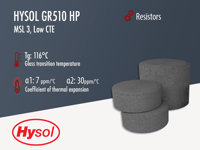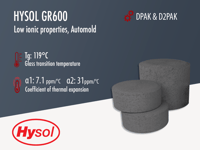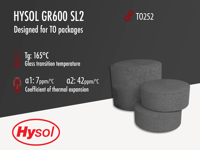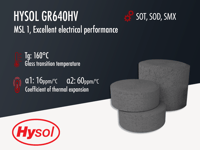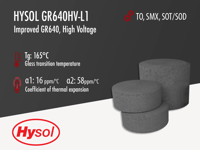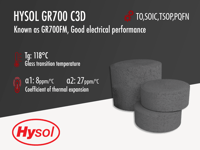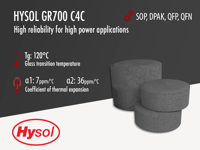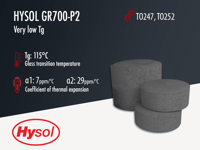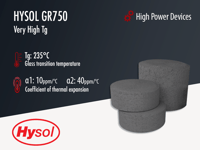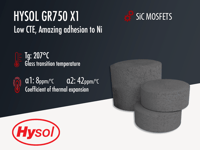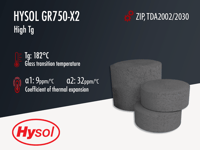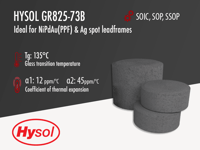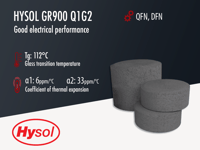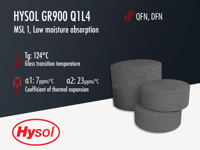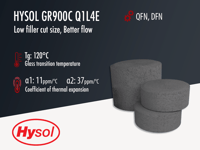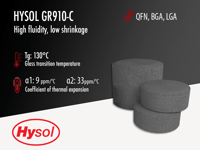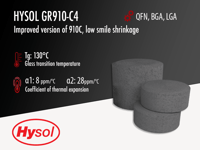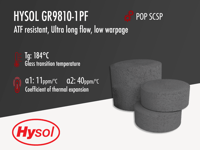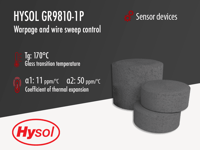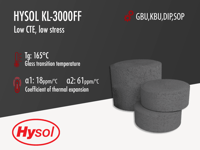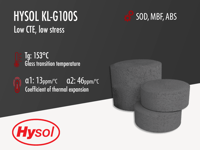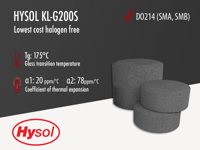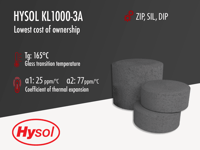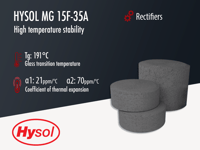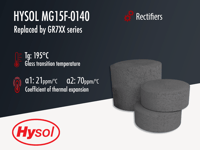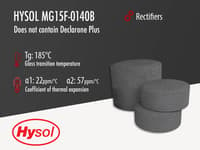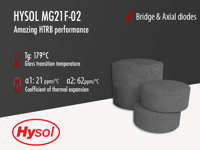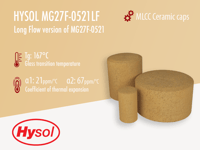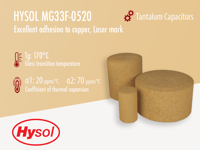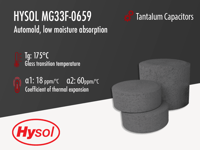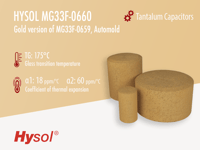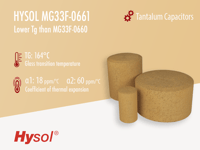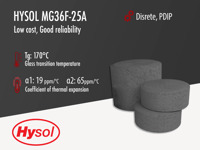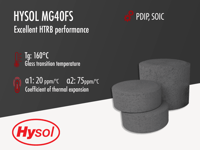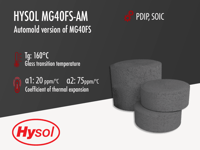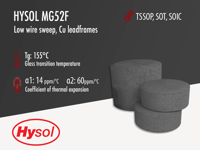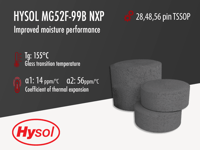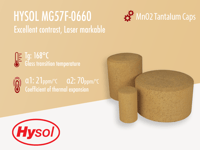Semiconductor Epoxy Mold Compounds
Semiconductor molding compounds are fine filled, electrically stable compounds, ideal for the miniaturised semiconductor packaging requirements. They have small filler sizes, great spiral flow and can be electrically stable at high temperatures.
Epoxy molding compounds that are graded for semiconductor use are CTE matched to common die substrates and are made with nano packages in mind. They cover and protect the die and the wirebonding while also passing the most stringent moisture and temperature tests.
Excellent electrical stability is desired for epoxy molding compounds used in the encapsulation of high power, discrete semiconductors applications that also operate a high temperatures.These molding compounds tend to have the lowest ionic content, the highest dielectric strength, the most stable dielectrics and the lowest ionic conductivity over the widest possible temperature range.
LINQSOL EMC-7560 | Black Epoxy Mold Compound
- High Glass Transition Temperature (205 °C)
- Designed for high voltage, high power discrete packages
- New Epoxy System To Pass HTRB Tests
- 8 weeks
Hysol GR720 | Black Epoxy Mold Compound
- High reliability
- Green and halogen-free
- Designed for SOT applications
- 12 weeks
Hysol KL1000-3LX | Black Epoxy Mold Compound
- High reliability
- High moldability
- Decreased cost-of-use
- 12 weeks
LINQSOL EMC-7535 | Black Epoxy Mold Compound
- Green molding compound
- Designed for high-power TO packages
- High Tg, low water absorption, low modulus, and excellent thermal stability
- 8 weeks
LINQSOL EMC-7142 | Black Epoxy Mold Compound
- Green epoxy molding compound
- Designed for SOP and QFP
- Low water absorption, low stress, and excellent moldability
- 8 weeks
LINQSOL EMC-7535MF | Black Epoxy Mold Compound
- Green molding compound
- Designed for high-power TO packages
- High Tg, low water absorption, low modulus, and excellent thermal stability
- 12 weeks
LINQSOL EMC-9070 | Black Epoxy Mold Compound
- MSL1 260°C
- Designed for QFN and DFN packages
- Moisture Corrosion Resistance
- 8 weeks
Hysol GR730HT| Black Epoxy Mold Compound
- Halogen free
- High adhesion
- High thermal conductivity
- 12 weeks
Hysol GR60 | Black Epoxy Mold Compound
- Designed for IPM application
- Good moisture resistance
- High thermal conductivity
- 8 weeks
Hysol GR15F-MOD2C | Black Epoxy Mold Compound
- Very High Glass Transition Temperature: 236°C
- Longer spiral flow than MOD2
- Designed for high voltage, high power discrete packages
- 12 weeks
Hysol GR21F-02 | Black Epoxy Mold Compound
- Amazing HTRB performance
- Green alternative to MG21F-02
- Encapsulation of low voltage diodes
- No longer available
Hysol GR2220 | Black Epoxy Mold Compound
- Designed for MnO-based tantalum capacitors
- Lower cost of ownership
- High productivity, easily moldable
- 12 weeks
Hysol GR2310 | Gold Epoxy Mold Compound
- For MnO2 Tantalum Capacitors
- Gold (yellow) colored
- Halogen-free version MG33F-0520
- 12 weeks
Hysol GR2310V | Gold Epoxy Mold Compound
- Long flow version of GR2310
- For MnO Tantalum Capacitors
- Gold (yellow) colored
- 12 weeks
Hysol GR2320 | Black Epoxy Mold Compound
- For MnO Tantalum Capacitors
- Black colored
- Halogen-free version of MG33F-0602 & MG33F-0593
- 12 weeks
Hysol GR2330 | Orange Epoxy Mold Compound
- For MnO Tantalum Capacitors
- Orange Colored
- Orange version of GR2310 and GR2320
- In stock
Hysol GR2710 | Gold Epoxy Mold Compound
- For conductive polymer and AO capacitors
- Excellent thin wall crack resistance
- Fast cure for automold equipment
- 12 weeks
Hysol GR2710FF | Gold Epoxy Mold Compound
- For conductive polymer and AO capacitors
- Excellent thin wall crack resistance
- Fine-filler version of GR2710
- 12 weeks
Hysol GR2720 | Black Epoxy Mold Compound
- For conductive polymer and AO capacitors
- Excellent thin wall crack resistance
- Fast cure for automold equipment
- 12 weeks
Hysol GR2811 | Gold Epoxy Mold Compound
- Very low stress
- Gold (yellow) colored
- Thin Wall Crack Resistance
- 12 weeks
Hysol GR2812 | Gold Epoxy Mold Compound
- Replaces GR2811
- Thin wall crack resistance
- MSL3 260°C capability
- 12 weeks
Hysol GR2820 | Black Epoxy Mold Compound
- For Conductive Polymer Tantalum Solid Capacitors
- Ultra-low stress
- Thin Wall Crack Resistance
- 12 weeks
Hysol GR2821 | Black Epoxy Mold Compound
- Completely Superseded by GR2820
- Ultra-low stress epoxy mold compound
- Thin Wall Crack Resistance
- 12 weeks
Product Selector Guide
| Product Name | Key Properties | |||||||||||
|---|---|---|---|---|---|---|---|---|---|---|---|---|
| Color | Filler Content (%) | Specific Gravity | Glass Transition Temperature (Tg), °C | CTE, Alpha 1 ppm/°C | CTE, Alpha 2 ppm/°C | Gel Time (s) | Ionic Content Na+/Cl- ppm | Spiral Flow (cm) | Thermal Conductivity (W/mK) | Packages | ||
| LINQSOL EMC-7142 | Black | 89 | 2.00 | 122 | 8 | 34 | 30 | 15 / 15 | 90 | - | SOP QFP | |
| LINQSOL EMC-7535 | Black | 75 | 1.96 | 176 | 13 | 37 | 24 | 15 / 15 | 86 | - | TO | |
| LINQSOL EMC-7535MF | Black | - | 1.96 | 215 | 9 | 35 | 29 | <15 / <10 | 85 | - | - | |
| LINQSOL EMC-7560 | Black | 85 | 1.95 | 205 | 10 | 52 | 30 | 10 / 10 | 82 | 0.9 | SiC MOSFET | |
| LINQSOL EMC-9070 | Black | 89 | 2.01 | 126 | 8 | 30 | 35 | 6.7 / 4.1 | 127 | - | QFN, DFN | |
| GR15F-MOD2C | Black | 81.5 | 1.93 | 236 | 15 | 42 | 31 | 5 / 5 | 109 | 0.78 | SiC MOSFET | |
| GR 2220 | Black | 75 | 1.82 | 161 | 18.5 | 63.3 | 18 | 3.6 / 10.4 | 81.28 | - | MnO2 Caps | |
| GR 2310 | Gold | 72 | 1.82 | 175 | 20 | 73 | 12 | 9 / 13 | 72 | 0.64 | MnO2 Caps | |
| GR 2310V | Gold | 72 | 1.85 | 180 | 18 | 70 | 28 | 9 / 19 | 114 | 0.7 | MnO2 Caps | |
| GR 2320 | Black | 71 | 1.8 | 170 | 20 | 75 | 14 | 4 / 10 | 76.2 | 0.7 | MnO2 Caps | |
| GR 2330 | Orange | 74 | 1.83 | 175 | 19 | 67 | 14 | 3 / 8 | 81 | 0.65 | MnO2 Caps | |
| GR 2710 | Gold | 81.7 | 1.93 | 161 | 13 | 51 | 15 | 5 / 8 | 105 | - | AO Caps | |
| GR 2710FF | Gold | 84 | 1.96 | 160 | 11 | 47 | 13 | 6 / 7 | 116 | 0.8 | AO Caps | |
| GR 2720 | Black | 79 | 1.87 | 160 | 18 | 58 | 19 | 2 / 5 | 96.5 | 0.7 | AO Caps | |
| GR 2811 | Gold | 85 | 1.96 | 162 | 13 | 45 | 15 | 1 / 7 | 86.3 | 2.7 | POSCAP | |
| GR 2812 | Gold | 90 | 2 | 105 | 7 | 29 | 20 | 2.7 / 7.7 | 73 | - | POSCAP | |
| GR 2820 | Black | 83 | 1.9 | 183 | 12 | 45 | 20 | 6.6 / 7 | 66 | - | POSCAP | |
| GR2821 | Black | 85 | 1.96 | 116 | 13 | 45 | 31 | 1 / 7 | 101 | 2.7 | POSCAP | |
| GR 2822 | Black | 88 | 1.98 | 105 | 7 | 36 | - | 2.9 / 8 | 99 | - | POSCAP | |
| GR 30 | Black | 81 | 1.9 | 183 | 13 | 57 | 17 | - | 62 | 0.95 | T0220/247 | |
| GR 300 | Black | 80 | 1.94 | 185 | 12 | 51 | 19 | 4.5 / 9.3 | 34 | 0.95 | T0220/93/252 | |
| GR 30HT | Black | 72 | 2.1 | 186 | 21 | 56 | 21 | 20 / 20 | 88 | 1.9 | T0/93 | |
| GR 350HT | Black | 79 | 2.13 | 182 | 20 | 62 | 28 | 15 / 8 | 61 | 1.6 | T0/220F | |
| GR 360A-ST | Black | 77 | 1.84 | 168 | 15 | 59 | 23 | - | 98 | - | Diodes,TO,DIP | |
| GR 510 | Black | 88 | 1.99 | 113 | 8 | 27 | 36 | 5 / 10 | 111 | - | QFP, SOT | |
| GR 510-HP | Black | 88 | 1.99 | 116 | 7.5 | 30.5 | 31 | 4 / 6.1 | 101.6 | - | Resistors | |
| GR 600-P1 | Black | 88 | 2 | 119 | 7.1 | 31 | 27 | 4.9 / 5.9 | 34 | - | DPAK/D2PAK | |
| GR 600 SL2 | Black | 87 | 2.03 | 165 | 7 | 42 | 27 | - | 83 | - | TO252 | |
| GR 640HV | Black | 74 | 1.83 | 160 | 16 | 60 | 26 | 5 / 10 | 75 | 0.85 | SOT,SOD,SMX | |
| GR 640HV-L1 | Black | 75 | 1.85 | 165 | 16 | 58 | 28 | 6 / 21 | 71 | - | TO, SMX, SOT | |
| GR 700 C3D | Black | 87 | 1.97 | 118 | 8 | 27 | 27 | 3 / 9 | 107 | 0.9 | TO,SOIC,PQFN | |
| GR 700 C4C | Black | 89 | 2 | 120 | 7 | 36 | 30 | 3 / 7 | 114 | 0.9 | SOP,DPAK,QFP | |
| GR 700-P2 | Black | - | - | 115 | 7 | 29 | 24 | >15 | 89 | - | TO247, TO252 | |
| GR 710F | Black | 88 | 1.98 | 115 | 9 | 37 | 31 | 9 / 4 | 93 | 0.86 | T0, SOIC16, TSOP, SSOP | |
| GR 750 | Black | - | - | 235 | 10 | 40 | 26 | >15 | 106 | - | SiC MOSFETS | |
| GR 750 X1 | Black | - | - | 207 | 8 | 42 | 24 | >15 | 92 | - | SiC MOSFETS | |
| GR 750 X2 | Black | 84 | 1.94 | 182 | 9 | 32 | 27 | 5 / 15 | 114 | 0.8 | ZIP,TDA2002 | |
| GR 825-73B | Black | 80 | 1.9 | 135 | 12 | 45 | 22 | - | 100 | 0.8 | SOIC, SSOP | |
| GR 900 Q1G2 | Black | 89 | - | 112 | 6 | 33 | 25 | 3 / 13 | 137 | - | QFN, DFN | |
| GR 900 Q1L4 | Black | 89 | 2.02 | 124 | 7 | 24 | 36 | 3 / 8 | 124 | 0.9 | QFN, DFN | |
| GR 900C Q1L4E | Black | 86.5 | 1.98 | 120 | 11 | 37 | 38 | 3 / 8 | 132 | - | QFN, DFN | |
| GR 910-C | Black | 88 | 2.01 | 130 | 9 | 23 | 47 | 4 / 7 | 203 | 0.9 | QFN,BGA,LGA | |
| GR 910-C4 | Black | 88 | 2 | 130 | 8 | 28 | 44 | - | 170 | 1 | QFN,BGA,LGA | |
| GR 9810-1P | Black | 85 | 1.95 | 170 | 11 | 50 | 32 | - | 150 | 0.9 | Sensors | |
| GR 9810-1PF | Black | 86 | 1.95 | 170 | 11 | 40 | 40 | - | 170 | 0.9 | POP, SCSP | |
| KL G200S | Black | 77 | 1.95 | 175 | 20 | 78 | 20 | 3 / 8 | 80 | 1.4 | DO214 | |
| KL 1000-3A | Black | 75 | 2 | 165 | 25 | 77 | 23 | 3 / 7 | 80 | 1.3 | ZIP,SIL,DIP | |
| MG 15F-0140 | Black | - | 1.81 | 195 | 21 | 70 | 17 | 3 / 5 | 50.8 | 0.66 | Rectifiers | |
| MG 15F-35A | Black | - | 1.82 | 190 | 21 | 70 | 20 | 20 / 20 | 64 | 0.7 | Rectifiers | |
| MG 21F-02 | Black | 71 | 1.81 | 179 | 21 | 62 | 22 | 4 / 6 | 65 | 0.7 | Diodes | |
| MG 27F-0521LF | Gold | - | 1.91 | 167 | 21 | 67 | 25 | 4 / 3 | 63 | 0.65 | MLCC Caps | |
| MG 33F-0520 | Gold | - | 1.87 | 170 | 20 | 70 | 14 | - | 64 | - | Ta Caps | |
| MG 33F-0659 | Black | 76 | 1.83 | 175 | 18 | 60 | 14 | - | 66 | - | Ta Caps | |
| MG 33F-0660 | Gold | 76 | 1.83 | 175 | 18 | 60 | 14 | - | 66 | - | Ta Caps | |
| MG 33F-0661 | Gold | 72 | 1.81 | 164 | 18 | 60 | 22 | - | 69 | 0.8 | Ta Caps | |
| MG 36F-25A | Black | - | 1.82 | 170 | 19 | 65 | 30 | - | 76 | - | Discrete, DIP | |
| MG 40FS | Black | - | 1.84 | 160 | 20 | 75 | 25 | 5 / 5 | 89 | 0.95 | PDIP, SOIC | |
| MG 40FS-AM | Black | - | 1.84 | 160 | 20 | 75 | 25 | 5 / 5 | 71 | 0.95 | PDIP, SOIC | |
| MG 52F | Black | 79 | 1.84 | 155 | 14 | 60 | 24 | 2 / 2 | 76 | 0.95 | TSSOP, SOIC | |
| MG 52F-99BNXP | Black | 79 | 1.88 | 155 | 14 | 56 | 21 | 2 / 2 | 78 | 0.95 | TSSOP | |
| MG 57F-0660 | Gold | - | 1.82 | 168 | 21 | 70 | 14 | 20 / 20 | - | - | MnO2 Ta Caps | |
| Product Name | Key Properties | |||||||||
|---|---|---|---|---|---|---|---|---|---|---|
| Color | Specific Gravity | Glass Transition Temperature (Tg), °C | CTE, Alpha 1 ppm/°C | CTE, Alpha 2 ppm/°C | Moisture absorption | Ionic Content Na+/K+/Cl- ppm | Spiral Flow | Thermal Conductivity (W/mK) | Dielectric Constant | |
| MG15F-35A | Black | 1.82 | 191 | 21 | 63 | 0.64% | 4/1/7 | 28" | 0.7 | 3.5 |
| MG21F-02 | Black | 1.81 | 179 | 21 | 62 | 0.61% | 4/1/6 | 26" | 0.7 | 3.6 |
| MG33F-0520 | Gold | 1.87 | 170 | 20 | 70 | - | 1.5/-/2 | 25" | - | 4.3 |
| MG33F-0661 | Gold | 1.81 | 164 | 18 | 60 | 0.42% | - | 27" | 0.8 | 4.1 |
| MG57-0660 | Gold | 1.82 | 168 | 21 | 70 | 0.42% | - | 30" | - | 4.2 |
| MG33F-0602 | Black | 1.80 | 162 | 22 | 65 | - | 2/-/7 | 43" | - | 3.9 |
Frequently Asked Questions
What exactly is an HTRB test?
A "High Temperature Reverse Bias" test is a common reliability test that exposes the power devices (and hence the EMC) to the "worst case scenario" under which it must perform and not fail. During the HTRB test, the power semiconductor devices are stressed at the maximum rated reverse breakdown voltage at a temperature close to their maximum rated junction temperature (Tj max) over a defined period of time. As such, a HTRB cannot be completely understood until the variables of voltage, temperature and time are defined.
What is the ionic content in epoxy mold compound that causes semiconductor device failure?
There are four main elements that should be minimized in epoxy molding compounds. There are Chlorine (Cl-), Sodium (Na+), Fluorine (F-) and Potassium (K+), where chlorine and sodium are the most important. All the ionic content shoudl be kept under 20ppm for each individual element and less than 5ppm is desired for Chlorine and Sodium.
What is Reverse Bias?
Basically, semiconductors allow current to flow in one direction: from the p-type (positive) to the n-type (negative). Reverse bias is applying direct current (DC) voltage to prevent current flow in a diode, transistor or similar. Wikipedia has a good desription in Reverse Bias
What is the relationship between Permittivity and Dielectric Constant?
The dielectric constant is unitless because it is actually the ratio of two permittivity values: the permittivity of the substance to the permittivity of the free space. Since the lowest possible permittivity is obtained in a vacuum, the permittivity of the substance is always higher and therefore the dielectric constant is always higher than 1.
What is Ionic Mobility?
Otherwise known as Electrical Mobility, it is the ability of charged electrons or protons to move through a substance (in this case epoxy mold compound) in response to an electric field that pulls them.
How can I decap ICs?
We could suggest the obvious mechanical methods but if you came here you probably want to preserve the integrity of the bond wires and the die. That\'s why, typically, customers use a Nitric or Sulfuric acid to etch away the epoxy. Though you should definitely take the necessary precautions with a hume hood, no inhalation, customers have used this successfully without damaging the wires. Here are almost 8 million words (30 fps, we did the math)
Learn More
Epoxy Molding Compounds
Epoxy Molding Compounds (EMC) by their nature have very good electrical insulation properties. Epoxy Mold Compounds are often called "functional epoxies" or "high solid epoxies" because they are heavily loaded with fillers. These fillers, (typically silica, though other fillers are used for other properties such as thermal conductivity) are loaded more than 50% by weight be default. Highly filled systems have weight % filler loadings higher than 70% with "very highly filled loadings" as high as 92% filled by weight.
These highly-filled systems provide epoxy molding compounds with very good dielectric strength and a very high breakdown voltage, which themselves are good electrical insulation properties. These two values however are poor indicators of what is meant by "Good electrical stability" for EMCs
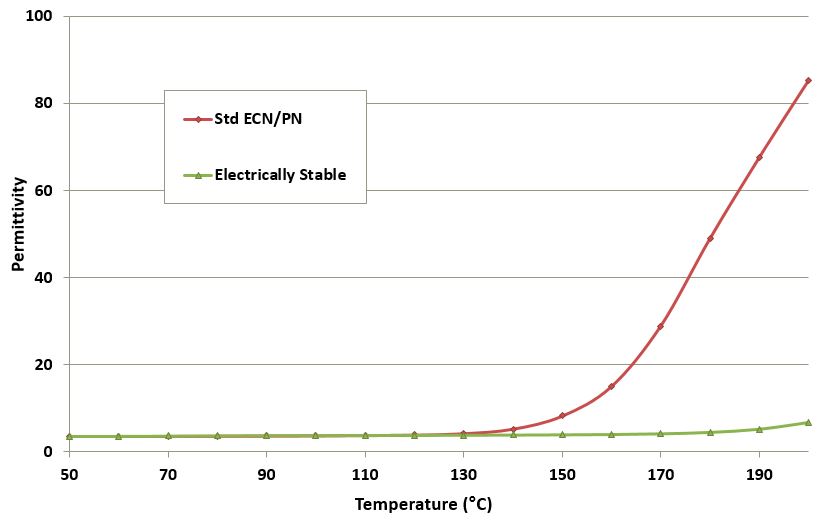
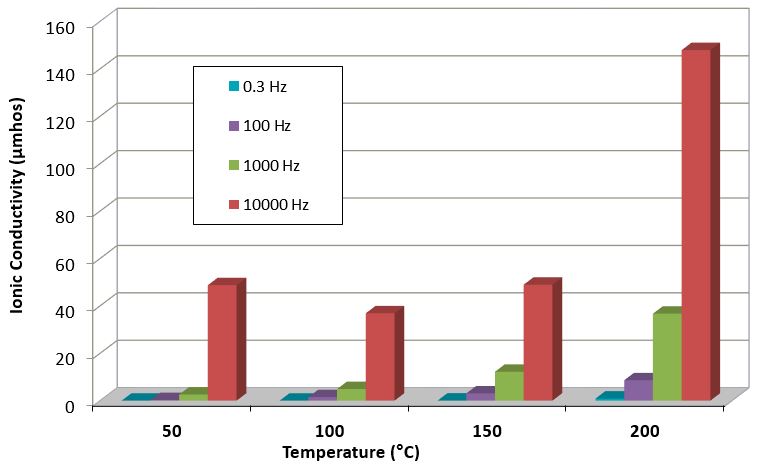
What do we mean by good electrical stability?
Good electrical stability means that there is very little ionic movement within the epoxy mold compounds when semiconductor devices are under reverse bias at elevated temperatures. The High Temperature Reverse Bias (HTRB) reliability test is an excellent industry-developed and accepted test that tests the electrical stability of EMCs
Epoxy mold compound that are considered to have excellent electrically stability are thus those that:
- Have low ionic conductivity
- Have a low and stable permittivity at temperatures up to 200°C
- Have a high dielectric strength
- Have a stable dielectric constant over a frequency range from 1 kHz up to 1.8 GHz
What causes poor electrical stability in mold compounds?
There are two main causes of poor electrical stability in EMCs:
- The ingredients used have high ionic content
- The epoxy resin and hardner combination has high ionic conductivity
EMC subcomponents have high ionic content
Epoxy molding compounds are made up of many components including epoxy resins, curing agents, catalysts, fillers, pigments and additives. Each of these ingredients can contain ions in the form of chlorine (Cl-), Sodium (Na+), Fluorine (F-) and Potassium (K+). There are elements other than these that have ions, but these are the ions most frequently present and in the highest quantities - therefore are of the greatest interest. As you can see next to the elements listed, Chlorine and Fluorine both have negative (-) ions and Sodium and Potassium both have postitive (+) ions.
Of these four elements, the biggest culprits are Chlorine (Cl-) and Sodium (Na+). If the total ionic content is too high, or the ionic content of each of the Chlorine or Sodium is too high, then the risk of gate current leakage and device malfunction increases. In all semiconductor applications, it is prudent to have the total extractable ionic content to be less than 80ppm and the extractable content of each element to be below 20ppm. In high power semiconductor applications which operate at higher voltages and higher temperatures, it is better to have the total ionics to be below 20ppm, and of each element to be below 5ppm. As application temperature and power increase, the lower the ionic content the better.
Epoxy resin/hardner combination has high ionic conductivity
When exposed to the electric field caused by the DC voltage applied, these ions have a tendency to move. If they move too much, a gate current leakage occurs and gradually increases which ultimately leads to the device malfunction.
Different combinations of epoxy resin and hardener, will provide different ionic conductivities of the base epoxy. Specifically, as illustrated in Figure 1 below, a standard epoxy cresol novolac resin with a standard phenolic resin might have a low permittivity at lower temperatures, but quickly elevate at higher temperatures leading to gate current leakage failures for power semiconductor devices.
Why is electrical stability important for EMC?
The roadmap for medium and high voltage power semiconductors manufacturers is to move from Silcion (Si) die to Silicon Carbide (SiC) and Gallium Nitride (GaN) semiconductors. SiC offers the possibility of operating at higher voltages compared to Silcion, whereas GaN offres the possibility of medium power with a much higher switching frtequency compared to Silicon.
As such, even silicon can applications have applications up to 600V which requires good electrical stability for epoxy mlding compounds. As these applications switch to SiC which can run up to 3300V, the need for improved electrical stability will only be greater.
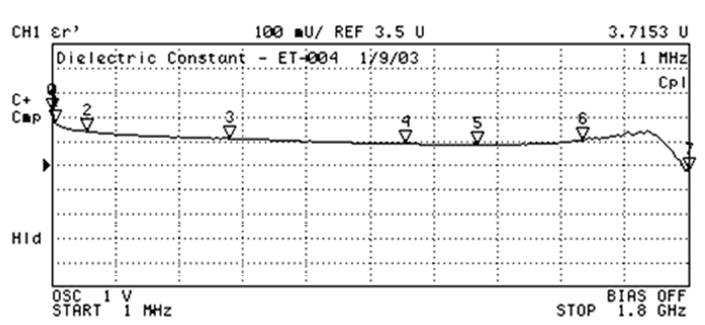
Formulating electrically stable Molding Compounds
Epoxy mold compound formulators can develop materials that will pass the HTRB test by developing EMCs that:
- Have low ionic content, low ionic content and low ionic mobility
- Use ion trappers
- Have low permittivity
- Use epoxy resin & hardener combinations that have the lowest ionic content and mobility
Selecting Semiconductor Mold Compounds
When looking for epoxy molding compounds that are very electrically stable, look for the following characteristics:
- Look for epoxies with a low permittivity over a wide temperature range as in Figure 1.
- Look for epoxies with a low ionic conductivity over a wide frequency range and at elevated temperatures as in Figure 2
- Look for epoxies with a stable dielectric constant up to 1.8 GHz as in Figure 3.


